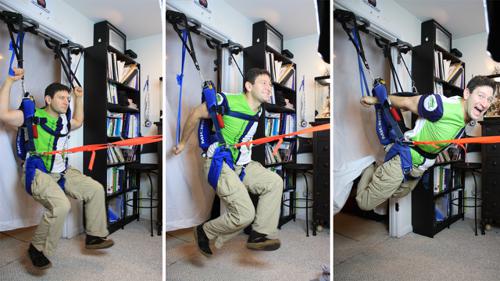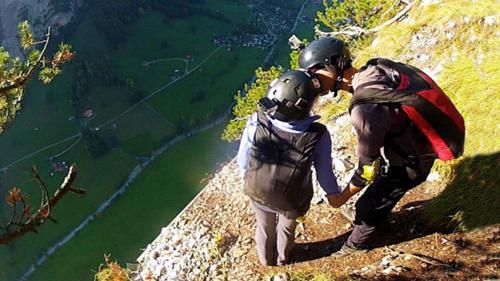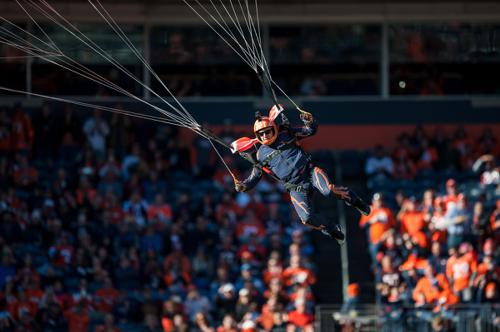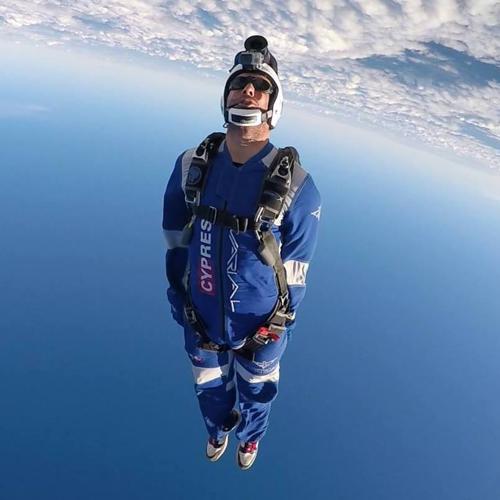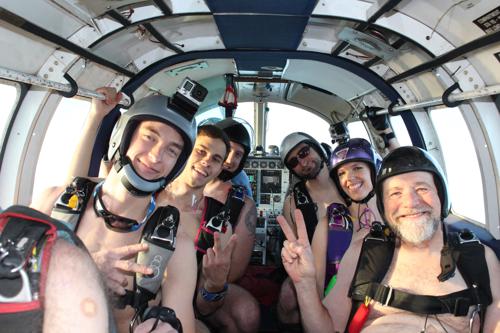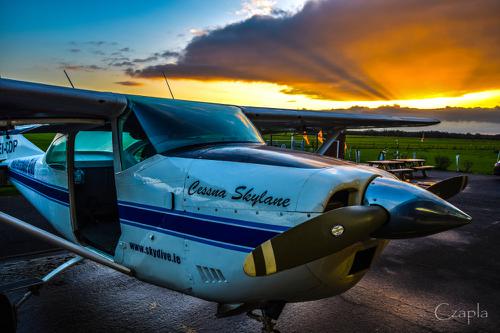Staying Current During Winter
The winter months are a great opportunity to catch up on all the things we weren’t doing throughout the summer, such as working on our homes, engaging in winter sports, and mending relationships with our non-skydiving friends. It is also a time that can lead to a dulling of our skydiving abilities, and our memory of correct procedures. As a result, the period following a substantial break can be a very dangerous time for skydivers, and a great many injuries come as a direct result of a lack of currency. If we are creative, however, we can keep our skydiving minds warm even when it is cold outside.
If you own a rig, for instance, it is quite easy to set up a hanging harness in your house. We have been using a secure chin-up bar for many years, and it works great. All you need is an extra pair of risers, a set of soft links, two climbing carabiners and a doorway. A retired pair of 18 inch risers work best for most doorways, to keep you high enough above the ground to create a good simulation. First, attach the tops of the spare set of risers together with the soft links. Next, loop the risers over the chin-up bar, and attach a carabiner to the large ring on the bottom of the risers. Then all you need to do is clip the carabiners through the three ring attachment hardware on your rig and you are ready to train. Keep in mind that if you are unsure about the security of your chin-up bar or door frame structure, be sure to wear a helmet and have a cushion underneath you just in case things go badly.
Some of you are thinking, I don’t need to practice pulling my handles all winter, I am a licensed skydiver. I know what I’m doing. Although we all know this is not the truth, everyone needs to practice their emergency procedures, the point of hanging yourself up goes far deeper than just practicing pulling your handles. There are a great many things you can rehearse and learn while suspended in your own rig. I am not talking about the tired old harness at the dropzone that does not remotely resemble the one you jump. I am embarrassed for our sport when I do not even find one of these old beaters hanging at a training facility. That needs to change. No, I am talking about your own personal rig: your handles, your harness, your home.
There are several things you will love about this initially embarrassing practice. One huge benefit is to practice transitioning from your deployment harness configuration to the flying and landing configuration. For most of us, this involves loosening the chest strap, and experimenting with different methods of moving the leg straps slightly forward to make yourself more comfortable.
By sitting in the harness for long periods of time, your body can change and become stronger in the ways that allow you to be more comfortable under canopy. You can also explore harness turn inputs by swinging side to side by loading one legstrap at a time, which may illuminate a need to relocate the elastic butt strap between your legstraps. This “freefly bungee” is great for preventing a legstrap from sliding forward in freefall, but if located too high or too short, can prevent harness turn capability while under canopy. A “fastex” pinch-release can allow you to remove this strap entirely, and hanging harness training can prepare you for the new muscle memory of your procedural change.
Hanging harness training will also allow you to practice flaring and leaning forward for landing. You can even tie webbing straps to the legstrap articulation hardware and have a friend pull your legs forward when you flare to simulate the pitch change, allowing you to rehearse leaning forward as the canopy pitches back to a higher angle of attack. This will help you to remain in balance for the touchdown, and by rehearsing this process in your downtime, you may even emerge from the ice and snow with more skill than the previous summer. Further, you can maintain your upper body strength in the canopy-specific muscles by lifting yourself up by the front risers dive loops, and by pulling on elastic bungee cords or “thera-bands” attached to the chin-up bar. These are easily acquired from most physical therapists, drug stores or apothecaries.
By using carabiners to attach yourself to the suspension system, you will be able to avoid the need to remove your main parachute for the simulation. It will feel slightly different with your main parachute still in the pack tray, but it will be close enough to make the practice a valid training method for staying fresh through the chilly months. It is also helpful to remove your main from time to time, and attach the suspended risers to your rig’s three ring system to practice cutting away. A mattress, helmet and spotter is a really good idea for this practice. This will help you to get a clearer picture of what it actually feels like to chop your main, and may even result in your awakening to the fact that your method of pulling the handles needs work, or that your cutaway system requires lubrication. Be sure not to actually pull your reserve ripcord unless you have a rigger handy. When you do bring it in for your spring repack, definitely give that reserve ripcord a go in a full simulation. All good training requires accurate, complete rehearsal of what you will need to do in the sky.
For wingsuit flyers, a hanging harness can be a fantastic training tool for staying current with the post-deployment sequence. Gear up fully and practice riding through the deployment with your knees together and your hands on the three rings. Then rehearse unzipping your arms, unstowing the toggles, loosening the chest strap and then unzipping and dressing your legs. For increased realism, try aiming a carpet blower up at you at the approximate glide angle of the canopy to simulate the relative wind. This will add the pressurization of the wings, making the process surprisingly like the real thing.
If you wear your helmet as you do all of this, the simulation will be quite realistic and highly beneficial. Such rehearsal will be very helpful for keeping the habits that save your life fresh in your mind. Be sure to practice malfunction procedures with your wingsuit on as well. The only thing you need to worry about is the doorbell, and the awkward explanation to the mailman.
Freefall skills are harder to keep fresh, unless you have a wind tunnel nearby. There are ways, however, to keep sharp without spending a lot of money. An FS “creeper” is a fantastic tool for practicing your belly flying, and creeper parties are a fun way to get jumpers together in the colder months. You can even have creeper competitions to stay on your game. It may feel a bit silly at times, but it is far better than trying to remember the dive pools all over again when the snow melts. I also find that an indoor swimming pool is a great asset in the winter, allowing you to work in three dimensions and play with new possibilities, especially if you have fun-loving skydiver friends. Nose plugs are really helpful for upside down swimming.
I also enjoy pulling out my gear in the winter and taking the time to slowly and methodically look over all the details I may not have had the time to check during the fast-paced summer months. Even if you are not a certified rigger, this is your gear and you need to be comfortable with every aspect of the equipment that saves your life. Pull out your main and climb inside your cells; inspecting the crossports, the seams, and the reinforcing tapes. Look for broken stitches, pulls, and damage to the fabric that may have occurred during the jumping season.
Inspect the bottom of your lines, your connector links and risers. Be sure to run your finger inside the slider grommets to check for rough spots that will damage your lines. You can also check your line trim by cutting the main away and tying the risers to something secure like a door hinge. By pulling tension on each line group in bilateral symmetry and comparing back to the center cell, you will learn volumes about the condition of your parachute. If you have spectra lines, you will be amazed how much your outboard lines and brakes will shrink over time through friction against the slider grommets, and from lack of loading. For a detailed education on main parachute inspection and an eye-opening retrimming technique, check out this video.
Another powerful way to keep your head in the skydiving game is through watching videos. There is a great deal of eye candy on the internet, although not all of it falls under the category of training, or even positive visualization. Be careful what you watch, visualization is a powerful form of training, and some of what you watch can pave the way to higher levels of fear. Furthermore, watching lots of poor technique can dull your image of the “right” way to fly.
Fortunately, there are some fantastic instructional videos available, which can actually expand your skydiving knowledge as the snow falls. The Australian Parachute Federation, for instance, created a fantastic malfunction video series called Cutaway. Additionally, here is a link to an in-depth Parachute Flight Safety Video Series, a canopy course ground school for all levels that will far exceed your expectations.
To further the goal of expanding your skydiving skill through knowledge, there are also several incredible podcasts on the internet that can bring a wealth of knowledge to your computer, phone or tablet. Skydive Radio, Jump Twenty Six and Radio Skydive UK all provide a wealth of information that can enhance your abilities and literally extend your life. Interviews with leaders in the sport will expand your knowledge of the essential history of skydiving, safety practices, and secrets to get the most out of your airtime. Best of all, you can enjoy this learning in the comfort of your own earplugs.
When we remember that most of what it means to be a skydiver actually happens on the ground, it becomes more than obvious that we do not need to turn off our skydiving brains once the chill hits the air. Although it is true that a flight to someplace warm is the best way to stay current in the winter, it is not the only way to continue being a skydiver. With a bit of open-minded creativity and ingenuity, we can continue our training all year long, and even emerge in the springtime with a deeper understanding than we had before. Freezing our thoughts about something we love this much not only increases our risks, it also costs us a piece of ourselves. Pull out your gear and keep the feeling alive, you will be glad you did.
-BSG
Brian Germain is a parachute designer, author, radio personality, keynote speaker, and has been an active skydiver for 30 years. You can get more of Brian’s teaching at Adventure Wisdom, Big Air Sportz, Transcending Fear, and on his vast YouTube Channel

